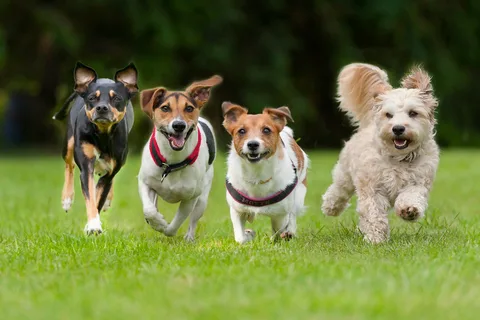Dog aggression can be a challenging issue for pet owners, posing risks not only to the dog but also to others around them. Whether the aggression stems from fear, territorial instincts, or past trauma, addressing it with proper training is essential for a harmonious relationship between dogs and their families. It is important to create a safe home for everyone, including our furry friends. Training your dog can significantly improve safety, communication, and trust. In this blog, we explore the benefits of aggression training, effective methods, and how we as owners can help ensure a safer environment for everyone.
Table of Contents
Understanding Dog Aggression
Dog aggression is not a one-size-fits-all problem. It can manifest in various ways, including growling, barking, lunging, or biting. It’s important to recognize that most aggressive behaviors are rooted in fear or anxiety. For example, dogs may become aggressive when they feel trapped or threatened, and some breeds may exhibit territorial or protective tendencies more than others.
Understanding triggers is crucial. These triggers can include unfamiliar people, other animals, or even specific environments. By identifying and addressing these triggers early, we can help reduce aggressive tendencies and prevent potentially dangerous situations. An early intervention is key to keeping everyone safe.
Key Benefits of Dog Aggression Training
- Enhanced Safety Aggression training reduces the likelihood of bites or attacks, ensuring the safety of both the dog and those around them. Managing and de-escalating aggressive situations is a critical component of keeping everyone safe, especially when young children are involved.
- Building Trust Training fosters a stronger bond between dogs and their owners by establishing trust and communication. Consistent training routines build confidence in dogs, reducing anxiety and fear-based behaviors. This means fewer stressful situations and more quality time with your pet.
- Improved Socialization Proper training helps dogs interact better with other animals and humans. Early and ongoing socialization is essential for preventing fear-based aggression and fostering a calm temperament. A well-socialized dog is not only safer but also more enjoyable to be around during playdates and family outings.
- Better Communication Aggression training enhances a dog’s ability to understand and respond to commands, making it easier for owners to guide their behavior. Reward-based methods encourage desired behaviors and make training a positive experience for both the dog and the family.
Effective Training Techniques
- Positive Reinforcement Positive reinforcement remains a cornerstone of aggression training. Rewarding desired behaviors with treats, toys, or praise creates a positive association and helps dogs learn more effectively. This method is particularly helpful for building trust and confidence in fearful dogs.
- Desensitization and Counterconditioning These methods involve gradually exposing a dog to their triggers in a controlled environment while rewarding calm behavior. This might mean helping your dog adjust to the chaos of a busy household or introducing them to other pets slowly.
- Controlled Socialization Gradual exposure to other dogs and people helps reduce fear and build confidence. Structured interactions in a safe environment prevent the escalation of aggressive tendencies and help dogs feel more comfortable in social settings.
The Role of Professional Trainers
Professional dog trainers bring expertise and experience that is invaluable for addressing aggression. Trainers should have a proven track record of success, specialized knowledge of dog behavior, and experience working with aggressive breeds.
Trainers provide:
- Personalized Plans: Tailored approaches that address a dog’s specific triggers and needs.
- Safe Environments: Controlled settings where dogs can learn without undue stress.
- Owner Education: Guidance for families on maintaining consistency and reinforcing positive behaviors at home.
Professional guidance can be a game-changer, offering peace of mind and tangible results.
Case Studies: Success Stories
- Max’s Transformation Max overcame severe anxiety and aggression through a combination of gradual desensitization and consistent obedience training. With patience and dedication, his behavior improved significantly. His story reminds us that even the most challenging cases can see progress with the right approach.
- Bella’s Journey Bella, a rescue dog with fear-based aggression, benefited from targeted socialization and positive reinforcement. Today, she’s a calmer, more confident companion. Her journey highlights the importance of giving dogs a second chance.
How to Start Aggression Training
- Research Trainers Look for trainers with experience in aggression cases and proven qualifications. A skilled trainer can make all the difference in addressing your dog’s specific needs.
- Set Goals Define specific outcomes you want to achieve, such as improved socialization or reduced reactivity. Clear goals help measure progress and keep the training focused.
- Commit to Consistency Follow through with regular training sessions and reinforce positive behaviors at home. Consistency is key to long-term success and building trust with your dog.
Making training a family effort ensures everyone is on the same page, creating a unified approach to helping your dog.
Dog aggression training is not just about managing behaviors; it’s about creating a safe and loving environment for your pet and everyone around them. We juggle many responsibilities, but prioritizing our dog’s behavior benefits the entire family. By understanding triggers, utilizing effective techniques, and working with qualified professionals, you can transform your dog’s behavior and strengthen your bond.
If you’re ready to begin this rewarding journey, consider North Tampa Dog Training Academy. Their compassionate and experienced trainers can help you and your furry friend achieve lasting results. With their guidance, you’ll be on the path to a happier, safer, and more fulfilling relationship with your dog.


